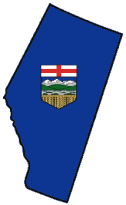| 1 | Mackenzie County |
| 2 | Wood Buffalo National Park |
| 3 | Wood Buffalo Regional Municipality |
| 4 | Northern Lights County
|
| 5 | Northern Sunrise County (East Peace) |
| 6 | Opportunity M.D. |
| 7 | Clear Hills County |
| 8 | Saddle Hills County |
| 9 | Spirit River M.D. |
| 10 | Fairview M.D. |
| 11 | Peace M.D.
Homesteaders began arriving around 1910. The municipal district of Peace #135 was established in 1916, and incorporated 2 Jan 1917. The office was first located in West Peace River, moved to Bear Lake Settlement in 1920, then to its present location in Berwyn about 1922. |
| 12 | Birch Hills County |
| 13 | Smoky River M.D. |
| 14 | Big Lakes M.D. |
| 15 | Lesser Slave River M.D. |
| 16 | Lac La Biche County (Lakeland) |
| 17 | Grande Prairie County
The first white man in the area is thought to have been Peter Pond, who, in 1778, explored the area seeking new territory for trapping. He created a map of the area which was published in 1785 and used by the North-West Company formed in 1787. By 1798 the NWC had established a trading post near present-day Fort St John. The Hudson's Bay Company's first post in the area was built in 1803 near present-day Fort Vermilion. By 1900 settlers had started trickling in but the area wasn't surveyed or settled in earnest until Walter G. McFarlane, a dominion land surveyor, and his brother James first surveyed the land in 1909 and then settled there in 1910. By 1912 the Rural Municipality of Grande Prairie had been established. |
| 18 | Greenview M.D. |
| 19 | Woodlands County |
| 20 | Barrhead County |
| 21 | Westlock County |
| 22 | Athabasca County |
| 23 | Thorhild County |
| 24 | Smoky Lake County |
| 24 | Smoky Lake County |
| 25 | St Paul County |
| 26 | Bonnyville M.D. |
| 28 | Yellowhead County |
| 29 | Lac Ste Anne County |
| 30 | Sturgeon County
Originally inhabited by Indigenous, later by Metis, and later still by homesteaders who took up land after the government had it surveyed. While the homesteaders spoke primarily English, the area also had a prominent French presence which is evidenced by the places names of Villeneuve, Morinville, and St Albert. |
| 31 | Lamont County |
| 32 | Two Hills County |
| 33 | Vermilion River County |
| 34 | Parkland County |
| 35 | Edmonton |
| 36 | Strathcona County |
| 37 | Beaver County |
| 38 | Minburn County |
| 39 | Jasper National Park |
| 40 | Brazeau County |
| 41 | Leduc County |
| 42 | Wetaskiwin County |
| 43 | Camrose County
Prior to European settlement, the area was inhabited primarily by Blackfoot and Cree tribes, the latter of whom were the main guides and traders for explorers and fur traders. During the fur trade many Metis families were created and many more moved from Manitoba. However documented European settlement started about 1881 when Father Beillevaire opened a mission on the south side of Battle River. He named the settlement Duhamel in honour of Archbishop Duhamel of Ottawa.
Camrose County is approximately 95 km long north to south, and 60 km wide west to east. The Battle River, which flows through the center of the county, was named after a war between the Cree and Blackfoot bands over hunting territory. The county includes the city of Camrose, Armena, Bashaw, Bawlf, Bittern Lake, Duhamel, Edberg, Ferintosh, Haylakes, Kelsey, Kingman, Meeting Creek, New Norway, Ohaton, Rosalind, Roundhill, and Tillicum Beach. |
| 44 | Flagstaff County |
| 45 | Wainwright M.D. |
| 46 | Clearwater County |
| 47 | Ponoka County
Established 1 Jan 1952 |
| 48 | Lacombe County |
| 49 | Red Deer County |
| 50 | Stettler County |
| 51 | Paintearth County |
| 52 | Provost M.D. |
| 53 | Banff National Park |
| 54 | Jasper |
| 55 | Bighorn M.D. |
| 56 | Mountain View County |
| 57 | Kneehill County |
| 58 | Starland County |
| 59 | Special Area #2 |
| 60 | Special Area #4
Homesteaders started arriving around 1900, however the land is in the dry belt and made for very difficult farming and many original settlers moved on to more fertile parts of Alberta. |
| 61 | Special Area #3 |
| 62 | Acadia M.D. |
| 63 | Kananaskis County |
| 64 | Rocky View M.D. |
| 65 | Calgary |
| 66 | Wheatland County
Settlers started arriving in 1883 when construction of the Canadian Pacific Railway reached the area. |
| 67 | Foothills M.D. |
| 68 | Vulcan County |
| 69 | Newell County |
| 70 | Cypress County |
| 71 | Ranchland M.D. |
| 72 | Willow Creek M.D. |
| 73 | Lethbridge County |
| 74 | Taber M.D. |
| 75 | Forty Mile County |
| 76 | Pincher Creek M.D. |
| 77 | Waterton National Park |
| 78 | Cardston County |
| 79 | Warner County |


